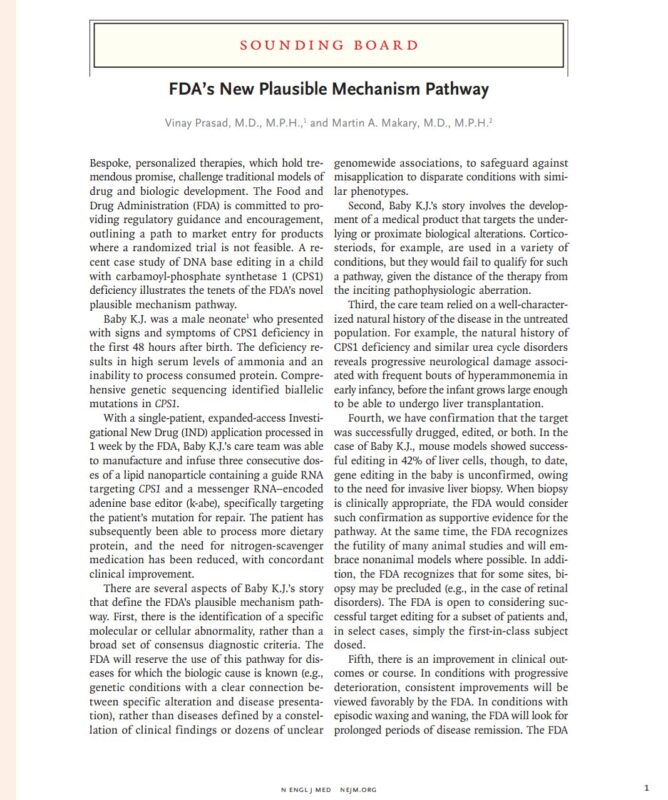A recent New England Journal of Medicine Sounding Board article by Vinay Prasad and Martin Makary outlines one of the most significant regulatory developments in modern therapeutics: the FDA’s new Plausible Mechanism Pathway (PMP). This pathway is designed to evaluate personalized, N=1 therapies—treatments so individualized that traditional randomized controlled trials are impossible. The PMP reflects the scientific reality that rapid sequencing, gene editing, and RNA-based manufacturing now enable bespoke interventions in time-sensitive, life-threatening situations.
The Case That Defined the Pathway: Baby KJ
A compelling example illustrating the need for this regulatory approach is the case of Baby KJ, a newborn diagnosed with CPS1 deficiency, a fatal single-gene metabolic disorder. In this instance, clinicians were able to design a customized adenine base-editing therapy, manufacture it, confirm key biological activity, and administer the treatment within the first week of life. The baby’s clinical improvements demonstrated the life-saving potential of individualized interventions when the molecular cause is clear and the disease progresses rapidly. This case symbolizes the type of medical scenario the PMP aims to support.

Core Requirements of the Plausible Mechanism Pathway
The PMP is intentionally narrow and relies on biological clarity. To qualify, a therapy must address a single well-defined molecular abnormality and act directly on that causal pathway. The disease’s natural history must be sufficiently well understood to allow reliable interpretation of clinical changes. Evidence of target engagement, demonstrated through cell or animal models, is required to justify the therapy’s mechanistic rationale. Finally, the patient must show meaningful and consistent clinical improvement.
Although the pathway begins with N=1 treatments, the FDA may eventually allow broader platform-based approvals if multiple similar cases, using the same therapeutic backbone, produce successful outcomes.
Potential Beneficiaries
The PMP primarily targets conditions where rapid and precise interventions can be lifesaving. These include ultra-rare genetic diseases, fatal childhood metabolic disorders, and single-gene defects with catastrophic trajectories. In the future, select pediatric cancers driven by a single dominant mutation may also become candidates. The pathway provides hope for patient populations traditionally left without actionable treatment options.
Who Is Excluded?
The authors emphasize that the PMP is not intended for common or biologically complex diseases. Multifactorial disorders, adult cancers with heterogeneous molecular drivers, and conditions with existing effective treatments fall outside the pathway’s scope. By maintaining narrow eligibility, the FDA aims to prevent inappropriate expansion and preserve scientific rigor.
Regulatory Expectations and Long-Term Monitoring
Because many of these therapies rely on gene-editing technologies with permanent effects, the FDA requires robust long-term surveillance. This includes extended safety monitoring for off-target edits, immune reactions, developmental effects, and late-onset complications. Real-world evidence, registries, and transparent follow-up will be essential to ensure ongoing safety and accountability.
Concerns Raised in the NEJM Article
Prasad and Makary caution that the pathway’s success will depend on disciplined implementation. They note the potential for industry overreach, especially if mechanistic criteria are not rigorously enforced. They also highlight the limited long-term safety data available for gene-editing technologies and stress the need for transparency in patient follow-up to maintain public trust.
FDA is Removing the “Black Box” Warnings of Breast Cancer from Menopausal Hormone Therapy Products
Why the Plausible Mechanism Pathway Matters
The introduction of the PMP marks a turning point in how regulators assess therapies when conventional clinical evidence cannot be generated. It acknowledges that individualized medicine is no longer theoretical—science has advanced to the point where patient-specific interventions may be the only viable treatments for certain diseases. The pathway may reshape care for patients with ultra-rare genetic conditions and, over time, influence precision oncology by supporting treatment of narrowly defined molecular subsets.
Ultimately, the Plausible Mechanism Pathway reflects a thoughtful, biology-driven shift toward truly personalized medicine, balancing innovation with long-term safety and scientific discipline.
Written by Nare Hovhannisyan, MD

